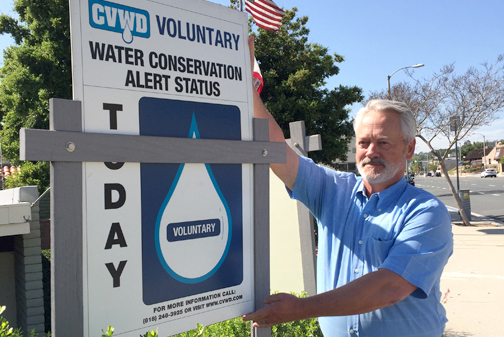
In March, Thomas Love of the CVWD changed the conservation status sign from Yellow-Extraordinary to Blue-Standard/Voluntary. Though Gov. Brown declared the drought emergency over, both he and Love advise ongoing vigilance regarding conservation efforts.
By Charly SHELTON
On Friday, Gov. Jerry Brown issued Executive Order B-40-17, ending the drought state of emergency. After this year’s unprecedented rainfall and snowpack, things are looking good. For now.
“This drought emergency is over, but the next drought could be around the corner,” Gov. Brown said in a statement released Friday. “Conservation must remain a way of life.”
The order lifted the drought emergency in all counties except Fresno, Kings, Tulare and Tuolumne where drinking water projects will continue to help provide relief. And while EO B-40-17 rescinds the emergency status, conservation actions will remain in effect to guard against falling back into a drought as Gov.Brown said.
Coinciding with this, state agencies issued a plan to establish new legislation to cement long-term and large-scale water conservation efforts and better planning for any future droughts.
In the Crescenta Valley, the Verdugo Groundwater Basin is still lower than it should be, said Tom Love, general manager of the Crescenta Valley Water District. It is at the lowest level it has been since record keeping began, and it’s 40% down from where it was when the drought cycle began. But the recent rains are still soaking in, and locally we will begin to see the levels rise a bit in the next month or so, with full saturation within 12-18 months. But this is not our only water resource.
“While the Verdugo Groundwater Basin is very low, the availability of imported water is great. That’s the water we get from Metropolitan Water District, through Foothill Water District, which comes from the Colorado River Aqueduct and the State Water Project,” Love said. “In fact, I’ve been watching the eight station index report – that’s the northern Sierra precipitation – and it is now 0.3 inches below the wettest year ever recorded. That’s a major part of the supply to the State Water Project.”
The rainfall was huge and things are improving, but the importing of water from out of the area is a tricky issue, going through many layers and agencies before reaching a faucet. As JPL Climatologist and Oceanographer Bill Patzert said earlier this year in an interview with CV Weekly, one year of heavy rain isn’t enough to fix everything.
“It took us many, many years to deplete the groundwater basins here in the San Gabriel Valley and there’s no quick fix,” Patzert said. “The other thing is our other two sources of water, which are imported water from northern California and the Colorado River. Lake Mead is at record low levels and it will take decades to refill it. Not years, but decades. And at this point, it’s not clear how much water the State Resources Board will allocate for Southern California this summer and into the fall. At this point, we’re importing 70% of our water, so who cares how much it rains here because it will take months, years to fill up the groundwater basins.”
It is hoped that the water imported from other agencies, such as Metropolitan Water District, will be allocated to the CVWD in great enough quantity this year so that CVWD will be able to maintain its Water Conservation Alert Status which the agency changed from Extraordinary to Standard/Voluntary two weeks before Gov. Brown lifted the state of emergency.
“Those that we call standard conservation practices should be practiced all the time,” Love said. “Some examples of what those include are no hosing down your driveway, don’t allow excessive runoff when watering your lawn, no watering within 48 hours after a rain, and more. In other words, for what it means to us, we already have those permanent water standards incorporated into our water conservation ordinance.”
